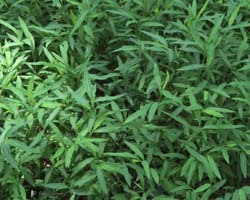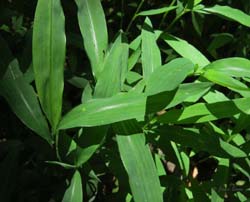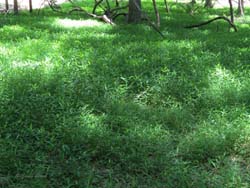Microstegium vimineum
Japanese Stiltgrass
[ click on any image below to see larger version ]
Family:
Poaceae
Mid-Atlantic bloom time:
August - October
Highly invasive, Japanese Stiltgrass (or simply, "stiltgrass") is an annual grass that was accidentally introduced into North America
from its native temperate and tropical Asia in the early 1900s.
It is thought to have escaped from its use as a packing material for porcelain, and
was first identified in America near Knoxville, Tennessee around 1919.
It occurs up to 4000 feet (1200 m) elevation, but flourishes on alluvial floodplains and streamsides.
Japanese Stiltgrass is very shade tolerant and produces prolific seeds (100 - 1000 per plant),
which can remain viable in the soil for at least three years.
It is commonly spread on trails and recreational areas by seeds that hitchhike on visitors' boots and shoes.
A key diagnostic aid to identification is the pale midvein in its leaves, usually slightly off center.
Also, its leaves are not wavy like the non-native Wavy Basketgrass (Oplismenus hirtellus, also invasive)
or the native basketgrasses (Oplismenus spp.).
Because its root system is shallow, small infestations of Japanese Stiltgrass can easily be removed by hand pulling before the
plants go to flower.
Extensive infestations are typically dealt with using herbicides.
20 June 2014
Manassas National Battlefield Park, Manassas, VA

|
20 June 2014
Manassas National Battlefield Park, Manassas, VA
(showing characteristic pale stripe in the near-middle of the leaves)

|
<20 June 2014
Manassas National Battlefield Park, Manassas, VA
(typical infestation overrunning all other low-lying species)

|
|
Return to list of flora


